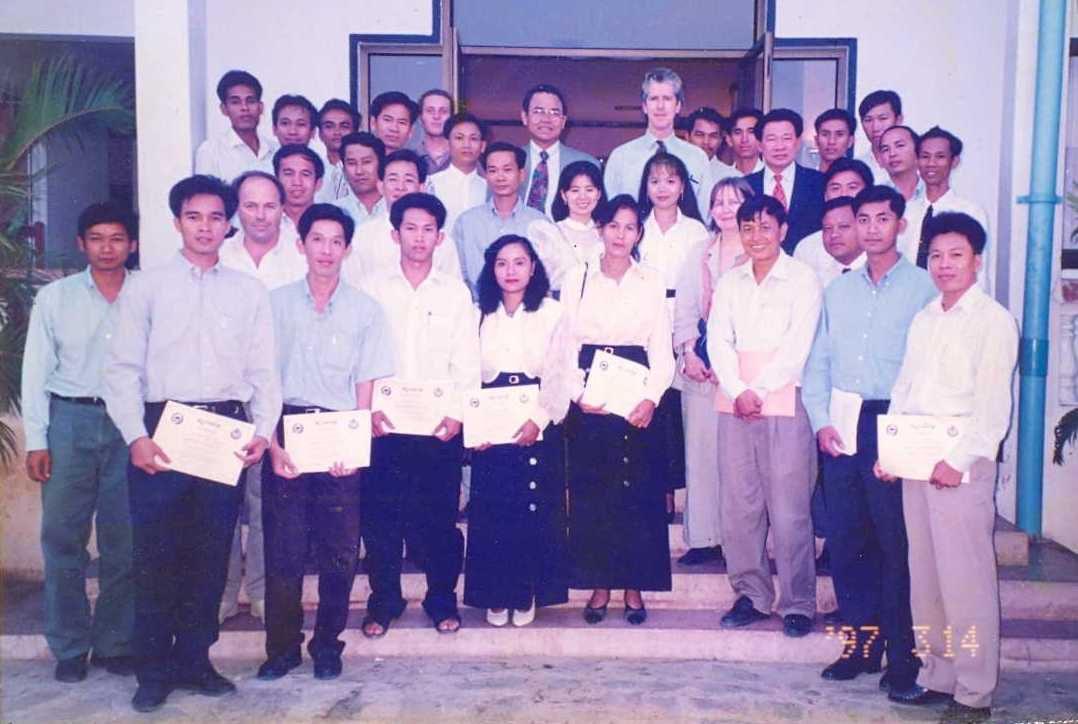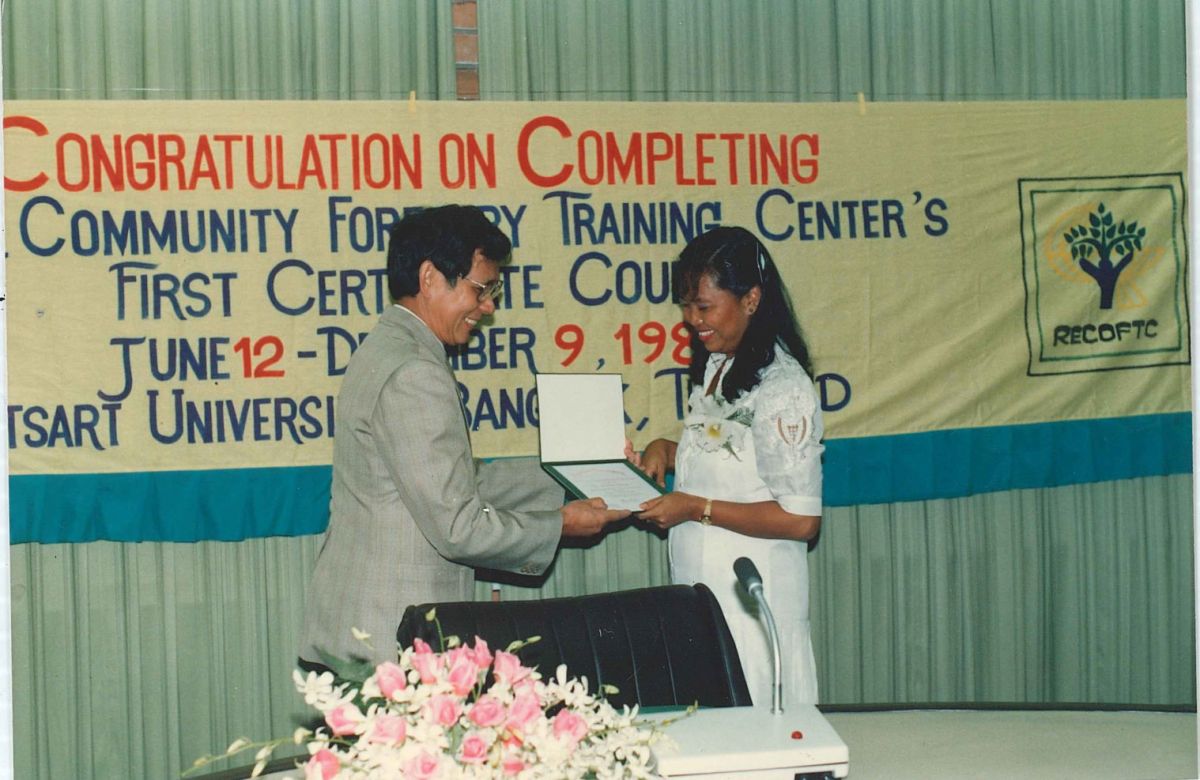

Pulling out his mobile phone, Kim Sarin proudly shows photos of smiling foreigners in a Cambodian forest. The ecotourism business, the official says, is a good example of how villagers can make a living from the environment they are empowered to protect.
“Many people come to the community to learn about the Cambodian way of life,” Kim says of the Chambok Community Protected Area venture in Kampong Speu Province. “The villagers show them how they manage the forest themselves and how they benefit from it—and the importance of self-sufficiency.”
For more than two decades, Kim has worked to develop and implement community forestry in Cambodia, an approach that allows people who depend on local forests to manage forests. A crucial part of the approach is supporting communities to not only protect the landscape but find new opportunities within the forests to sustainably improve their livelihoods.
As a young official in Cambodia’s environment ministry in the 1990s, Kim says RECOFTC’s training courses were instrumental in teaching him how community forestry can have positive social, environmental and economic impacts.
“I started to believe that community forestry can work because I can see the benefits that people can get from the forest,” says Kim, now a senior ministry official. “I still remember these important trainings.”

RECOFTC has spent more than three decades strengthening the capacity of officials throughout Southeast Asia to develop and implement reforms, policies and laws on community forestry. RECOFTC has trained more than 60,000 people since 1987.
With Southeast Asia’s forests under continuous pressure from population growth and rapid development, RECOFTC’s training courses, research, pilot projects and other work are more relevant than ever. Moreover, strengthening community forestry can help countries make progress not only on forest protection, but also on climate change and the Sustainable Development Goals.
For the villages in Kampong Speu Province, the ecotourism venture has meant years of planning and perseverance. Kim, who works with villagers in what are known as Community Protected Areas, started supporting the venture in 1998 through a feasibility study. The six villages have collaborated to build up the business, including by agreeing how much income should be allocated to each household and how much should be set aside for conservation and for patrolling the forest.
“There are sometimes conflicts among the villagers over the money, and there are other issues, such as encroachment on the land,” Kim says. “But we keep working with them, learning by doing and facilitating meetings so that we can come up with a solution.”
Women can lead the way
Meaningful participation by all stakeholders is a crucial part of successful community forestry, says Vong Sopanha, another graduate of RECOFTC’s training courses in the early 1990s. Women and other marginalized groups and others must therefore be included in discussions on forest governance and be empowered to act, says Vong, now one of the most senior women in Cambodia’s Forestry Administration.
“The male leaders make the decisions about their communities. They need to understand the benefits of including women in their plans because women are one of the main users of forests.”
“I say to them, ‘If you list the activities that need to be done, there are so many that women can manage,’" says Vong, a deputy director general of the Forestry Administration. “It’s not just about protection or cracking down on illegal logging.”
Vong, who has spent years encouraging and training women to become involved in forest management, is developing a national gender strategy for her administration, with assistance from Cambodia’s RECOFTC office.
“If we do something without strategy and without guidelines, then we have no clear direction,” she says.
While inclusive management and other good governance practices are key, so too are clear and secure land tenure and rights of local communities to use the forest and its resources. Even then conflicts arise, given the intense competition for land and the complexity of the issue.
Diffusing conflict
Malaysian forestry official Ricky Alisky Martin has implemented a string of initiatives over the years in Sabah State on Borneo island to resolve conflicts between national park officials and local communities who have long relied on the forests for survival.
RECOFTC’s community forestry courses help officials manage disputes by providing tools and strategies to promote discussion and collaboration between stakeholders.
Martin, one of the first Malaysian forestry officials to graduate from a RECOFTC course in 1988, recalled setting up Sabah’s first community forestry committee. The committee still meets several times a year to resolve conflicts between villagers and forestry officials in Deramakot Forest Reserve.

“We need social forestry in Sabah as a stabilizer or harmonizer for the conflicts that we have.”
Ricky Alisky Martin
In one area caught in dispute, community leaders agreed to help manage and conserve the nearby forest and Deramakot forestry officials agreed to pipe water from a forest stream into their homes and provide training on forest fire safety and other initiatives.
“From RECOFTC, I learned that good communication among all parties must be available,” says Martin, now head of the Social Forestry Section within the Sustainable Forest Management Division, Sabah Forestry Department. “We need social forestry in Sabah as a stabilizer or harmonizer for the conflicts that we have.”
Like Martin, many of the early alumni returned from their RECOFTC training and set about driving forward community forestry, then a relatively new concept in the region. They transferred their new knowledge to colleagues and developed networks across the board, seeing it as a solution to safeguarding forests and uplifting often poor communities. Community forestry today covers 13.8 million hectares in the region.

Education is the future
But their work is far from over. The region faces new challenges from climate change along with ongoing problems of deforestation, inequality and tenure. Knowledge transfer and education about how to tackle these issues is as important as ever. For Thailand’s Surin Onprom, that means focusing on the next generation of officials and practitioners.
“Students are the future policy makers,” says Onprom, who teaches forest resource management at Kasetsart University in Bangkok. “If we want to change things in the future, we need to start with today’s generation.”
Onprom, who has worked in community forestry for more than 20 years, including nine at RECOFTC, says it is crucial that students understand that tenure and other challenges need to be tackled in different ways, including by learning from local people themselves, because each community and forest are unique.
He regularly draws on RECOFTC’s field work and case studies, especially in Thailand, to show his students how this can be achieved. “If we have diverse communities, students need to be aware of different solutions that might be needed. There is not just one way.”
